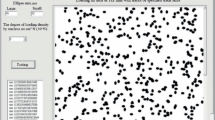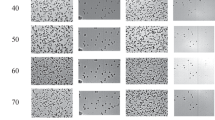Abstract
The detection and identification of heavy ions in phosphate glasses is based on an analysis of geometric parameters of tracks that manifest themselves upon the etching of irradiated glasses in a special solution. The shape and size of emerging tracks depend both on the parameters of the ions being studied (charge, energy, and angle of incidence) and on the etching conditions (etchant composition and concentration and etching time). Phosphate glass belongs to the class of solid-state tracking detectors whose principle of operation relies on the fact that multiply charged particles destroy a local solid-state structure along their trajectory. This local damage can be intensified by means of subsequent etching, whereby the tracks under study are visualized. The damaged parts of the material react with an etchant more intensely than intact parts do. This reaction leads to the formation of characteristic etching cones.The radiation damage of the material is proportional, as well as the specific energy loss of charged particles is, to the square of the particle charge and also depends on the particle speed.








Similar content being viewed by others
REFERENCES
V. A. Nikolaev, Solid-State Tracking Detectors in Radiation Studies (Politekh. Univ., St. Petersburg, 2012) [in Russian].
V. A. Nikolaev and V. P. Perelygin, Prib. Tekh. Eksp., No. 2, 7 (1976).
S. P. Tret’yakova, Phys. Part. Nucl. 23, 156 (1992).
G. N. Flerov, Yu. Ts. Oganesyan, Yu. V. Lobanov, Yu. A. Lazarev, S. P. Tret’yakova, I. V. Kolesov, and V. M. Plotko, At. Energy 29, 967 (1970).
V. P. Perelygin, Doctoral (Phys. Math.) Dissertation (Joint Inst. Nucl. Res., Dubna, 1993).
A. B. Aleksandrov, M. S. Vladimirov, L. A. Goncharova, N. S. Konovalova, G. I. Orlova, N. G. Peresad’ko, N. G. Polukhina, N. I. Starkov, M. M. Chernyavsky, and A. O. Shchelkanov, Instrum. Exp. Tech. 50, 469 (2007).
ACKNOWLEDGMENTS
The authors are indebted to professor Yu.Ts. Oga- nessian for suggestion of the subject and interest to the work, and also express gratitude for the support of the Flerov Laboratory of Nuclear Reactions of the Joint Institute for Nuclear Research.
Funding
The work was supported by the program no. BR10965191 (Complex Research in Nuclear and Radiation Physics, High Energy Physics and Cosmology for the Development of Competitive Technologies) of the Ministry of Education and Science of the Republic of Kazakhstan.
Author information
Authors and Affiliations
Corresponding author
Rights and permissions
About this article
Cite this article
Argynova, K., Burtebayev, N., Chernyavsky, M.M. et al. Identification of Multiply Charged Ions by Means of Detectors Based on Phosphate Glass. Phys. Atom. Nuclei 84, 866–873 (2021). https://doi.org/10.1134/S1063778821060065
Received:
Revised:
Accepted:
Published:
Issue Date:
DOI: https://doi.org/10.1134/S1063778821060065




